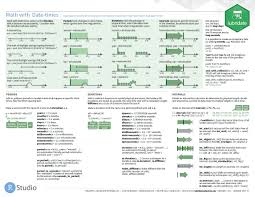Exploring Lubridate: A Powerful Date-Time Package in R
Lubridate is a popular date-time package in R that simplifies the handling and manipulation of date and time data. Developed by Garrett Grolemund, Lubridate provides a wide range of functions that make working with dates and times more intuitive and efficient.
One of the key features of Lubridate is its ability to parse various date-time formats easily. Whether you are dealing with dates in YYYY-MM-DD format or times with hours, minutes, and seconds, Lubridate can quickly convert them into a standard format for further analysis.
With Lubridate, you can perform a wide range of operations on date-time data, such as extracting specific components like year, month, day, hour, minute, or second. You can also calculate differences between two dates or times, add or subtract time intervals, and round timestamps to the nearest unit.
Furthermore, Lubridate offers seamless integration with other popular packages in the tidyverse ecosystem, making it easy to combine date-time manipulation with data wrangling tasks. Whether you are working on time series analysis, data visualisation projects, or any other data science task involving dates and times, Lubridate can streamline your workflow.
In conclusion, Lubridate is a versatile and powerful tool for handling date-time data in R. Its user-friendly functions and robust capabilities make it an essential package for anyone working with temporal data. By leveraging the features of Lubridate, you can enhance your productivity and gain deeper insights from your analyses involving dates and times.
Mastering Date and Time Manipulation in R: 6 Essential Tips for Using the Lubridate Package
- Use lubridate to easily work with dates and times in R.
- Remember to load the lubridate package using library(lubridate) before using its functions.
- Use functions like ymd() for parsing dates in year-month-day format.
- You can extract specific components of a date or time object using functions like year(), month(), day(), hour(), minute(), second().
- Perform arithmetic operations on dates by simply adding or subtracting time periods, e.g., adding days with days(5).
- Take advantage of lubridate’s powerful features for handling time zones and daylight saving time adjustments.
Use lubridate to easily work with dates and times in R.
By utilising Lubridate in R, users can effortlessly manage and manipulate dates and times with ease. This powerful package simplifies the handling of temporal data, allowing for seamless conversion between different formats and enabling users to perform a wide range of operations on date-time objects. Whether extracting specific components or calculating time intervals, Lubridate streamlines the process of working with dates and times in R, making it an indispensable tool for data analysis and manipulation tasks.
Remember to load the lubridate package using library(lubridate) before using its functions.
When working with Lubridate in R, it is important to remember to load the package using the command “library(lubridate)” before utilising its functions. By loading the Lubridate package at the beginning of your script or session, you ensure that all the date-time manipulation functions and capabilities provided by Lubridate are readily available for use. This simple step sets the foundation for seamless handling of date and time data, allowing you to efficiently perform various operations and analyses with ease.
Use functions like ymd() for parsing dates in year-month-day format.
When working with date-time data in R using Lubridate, it is highly beneficial to utilise functions like ymd() for parsing dates in the year-month-day format. This function simplifies the process of converting date strings into a standardised format that can be easily manipulated and analysed. By incorporating ymd() into your workflow, you can ensure consistency in handling dates and streamline your data processing tasks effectively.
You can extract specific components of a date or time object using functions like year(), month(), day(), hour(), minute(), second().
In Lubridate, users can easily extract specific components of a date or time object by utilising dedicated functions such as year(), month(), day(), hour(), minute(), and second(). This feature allows for precise manipulation and analysis of date-time data, enabling users to access and work with individual elements like years, months, days, hours, minutes, and seconds effortlessly. By leveraging these functions within Lubridate, users can streamline their data processing tasks and gain valuable insights from dissecting date and time information with precision.
Perform arithmetic operations on dates by simply adding or subtracting time periods, e.g., adding days with days(5).
In Lubridate, performing arithmetic operations on dates is made simple by using time periods to add or subtract specific intervals. For example, you can easily add five days to a date by using the function days(5). This intuitive approach allows for effortless manipulation of date-time data, making tasks such as calculating future or past dates a straightforward process. Lubridate’s ability to handle these operations with ease enhances the efficiency and clarity of date-time calculations in R.
Take advantage of lubridate’s powerful features for handling time zones and daylight saving time adjustments.
When working with date-time data in R, utilising Lubridate’s robust capabilities for managing time zones and daylight saving time adjustments can greatly enhance the accuracy and reliability of your analyses. By leveraging Lubridate’s powerful features in this area, you can ensure that your date-time calculations account for different time zones and seamlessly handle transitions due to daylight saving time changes. This capability not only simplifies the handling of temporal data but also enables you to maintain consistency and precision in your date-time operations across various geographical locations and time shifts.

